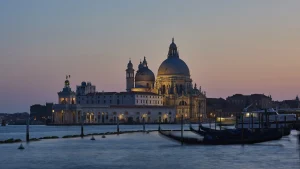Peggy Guggenheim Collection Venice: The Woman Who Made Modern Art Float
Imagine living in a Venetian palace where Pollock drips above your bed, Calder mobiles twirl in the lagoon breeze, and a pack of spoiled Lhasa Apsos race through marble halls. For most of us, that’s a fantasy. For Peggy Guggenheim, it was just another Tuesday in Venice.
This is the story of the most daring art collector the city has ever seen — a woman who turned her life into a masterpiece and her home into one of the world’s most enchanting museums: the Peggy Guggenheim Collection.
🎟️ Get Your Peggy Guggenheim Tickets
🇺🇸 From New York Heiress to Global Art Icon
Peggy Guggenheim was born in 1898 in New York City — into a dynasty of steel, silver, and scandal. Her father, Benjamin Guggenheim, perished heroically aboard the Titanic, but Peggy refused to let tragedy define her.
In her twenties, she escaped the stiff collars and debutante dinners of Manhattan for the artistic chaos of Europe. Paris, Berlin, London — wherever the avant-garde gathered, Peggy was there, drinking absinthe with poets and collecting art that would one day change the world.
In 1938, she opened her first gallery, Guggenheim Jeune in London, showcasing bold names like Kandinsky, Brâncuși, and Cocteau. By 1942, her New York gallery Art of This Century became the cradle of modernism, launching the careers of Jackson Pollock, Mark Rothko, and Willem de Kooning long before the critics caught up.
But it was Venice — luminous, eccentric, timeless — that finally stole her heart.
🛶 A Woman, a Palace, and a Gondola
When Peggy brought her collection to the 1948 Venice Biennale, the city didn’t know what hit it. While everyone else displayed Renaissance saints, Peggy hung Surrealists and Cubists — art that looked like dreams, chaos, and revolution all at once. The scandal was immediate. So was the fascination.
She soon bought Palazzo Venier dei Leoni, a low, unfinished 18th-century palace on the Grand Canal — a structure locals teasingly called “The Unfinished Palace.” Peggy saw not imperfection, but possibility. It became her home, her studio, and her stage — with masterpieces on every wall and a private gondola moored out front.
She’d glide through the canals in bold silk kaftans and massive black sunglasses, her dogs perched like furry royalty. One Venetian quipped: “If Venice were a movie, Peggy was the most interesting character in it.”
🐾 The Lady and Her Legendary Dogs
Peggy loved her Lhasa Apsos as deeply as her art. She built them their own cemetery in the garden, where they still rest today beneath the shade of bronze sculptures. She even hosted parties in their honor — complete with champagne, art-world gossip, and the occasional canine guest list.
When she passed away in 1979, Peggy’s ashes were placed right beside her beloved dogs in the garden of her palazzo. Even in death, she refused to be ordinary.
😎 Eccentric, Glamorous, and Fearlessly Herself
Peggy didn’t just live in Venice — she performed it. She wore mismatched earrings: one by Calder, the other by Tanguy. Her sunglasses were as sculptural as her art. She smoked constantly, swore creatively, and never apologized for being brilliant, bold, and delightfully impossible.
Venice adored her because she mirrored the city itself: chaotic, beautiful, unpredictable, and unforgettable.
🧑🎨 The Artists She Discovered (and Sometimes Loved)
The roll call of artists connected to Peggy Guggenheim reads like a syllabus for 20th-century art history:
- Jackson Pollock — She funded him when nobody else believed in him.
- Max Ernst — She married him (briefly, and dramatically).
- Alexander Calder — His mobiles danced through her living room.
- Yves Tanguy, Miró, Mondrian, Braque, Duchamp — All found sanctuary in her collection.
- Marino Marini — His bronze horse and rider still guard her garden today.
Her Venice palace became a living salon — part museum, part bohemian paradise — where the world’s greatest artists came to dine, argue, and dream beside the Grand Canal.
🖼️ The Peggy Guggenheim Collection Today
In 1951, Peggy began opening her home to the public each summer. Visitors would wander through her salon, stepping over her dogs, to find Picasso in one corner and Dalí in another — sometimes with Peggy herself narrating the stories behind the art, often with wicked humor.
Today, the Peggy Guggenheim Collection remains one of the most beloved museums in Europe — intimate, elegant, and deeply personal. It’s not just a gallery; it’s a diary in oil and bronze, written by a woman who changed art forever.
🎟️ Book Skip-the-Line Peggy Guggenheim Tickets
✨ Venice Through Peggy’s Eyes
If you want to walk in Peggy’s footsteps (and maybe her fabulous shoes), here’s your must-do list:
- 🏛️ Explore the Peggy Guggenheim Collection — and don’t skip the sculpture garden.
- 🌅 Stroll along the Zattere promenade, where Peggy walked her dogs and watched the sunset.
- ☕ Cross the Accademia Bridge and imagine her judging your outfit from a café window.
- 🛶 Take a Private Gondola Ride — preferably in big sunglasses and your most dramatic scarf.
Want to see Venice the way Peggy did — up close, privately, and through stories that only locals know? Join our Off-the-Beaten-Path Tour and discover the neighborhoods and inspirations that shaped her world.
🎨 Explore Venice Like Peggy Did
📍 Plan Your Visit
Peggy Guggenheim Collection
Palazzo Venier dei Leoni, Dorsoduro 701, Venice
Opening Hours: Wednesday–Monday, 10:00 AM – 6:00 PM (Closed Tuesdays)
Tip: Buy skip-the-line tickets in advance — queues can stretch along the canal during peak season.
🎟️ Reserve Your Peggy Guggenheim Experience
Venice gave her a home. She gave it a soul. Go see where modern art met the Grand Canal.
FAQs for Peggy Guggenheim Collection Venice: The Woman Who Made Modern Art Float
Where is the Peggy Guggenheim Collection located, and how do I visit it?
The museum sits right on the Grand Canal, inside Palazzo Venier dei Leoni in Dorsoduro — Peggy’s former home. It’s open Wednesday to Monday, 10:00 AM–6:00 PM (closed Tuesdays). To avoid lines, grab skip-the-line tickets for the Peggy Guggenheim Collection or include it in a Venice on Your Own itinerary with Tour Leader Venice.
What makes the Peggy Guggenheim Collection special?
It’s one of Europe’s finest modern-art museums — but it feels like walking through Peggy’s private home. You’ll see works by Pollock, Picasso, Dalí, Miró, Calder, Magritte, Kandinsky, and many others displayed just as she lived with them. Her sculpture garden and even her dogs’ resting place remain part of the story. The experience blends art, history, and eccentric personality — all in the heart of Venice’s Dorsoduro district.
What else can I explore nearby?
Pair your museum visit with a stroll across the Accademia Bridge, or join a Private Off-the-Beaten-Path Tour to uncover the artistic spirit that inspired Peggy’s Venice. For more masterpieces, book skip-the-line tickets to the Accademia Gallery or a Venetian Lagoon Tour for a scenic balance of art and water.







